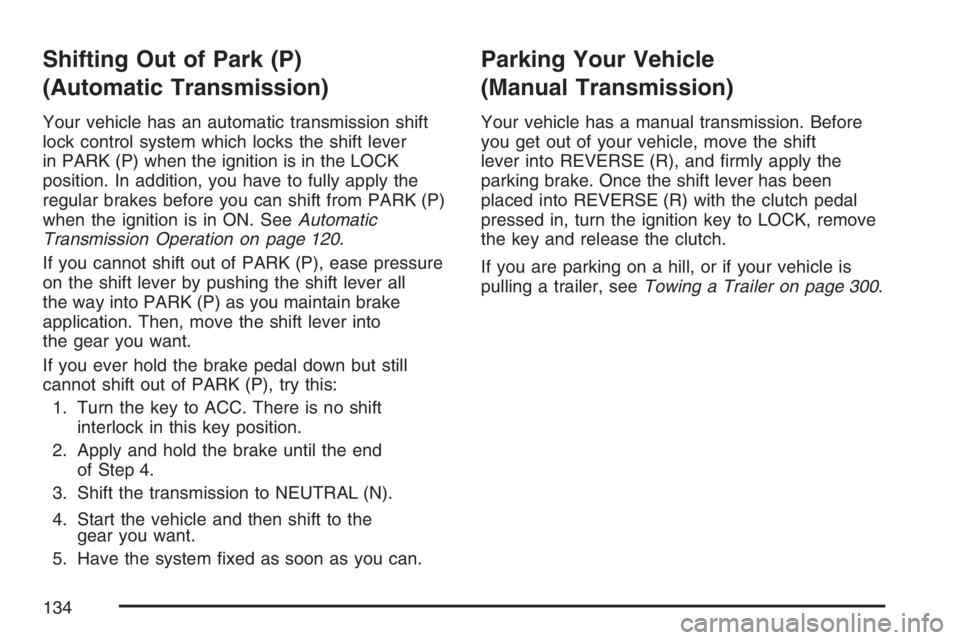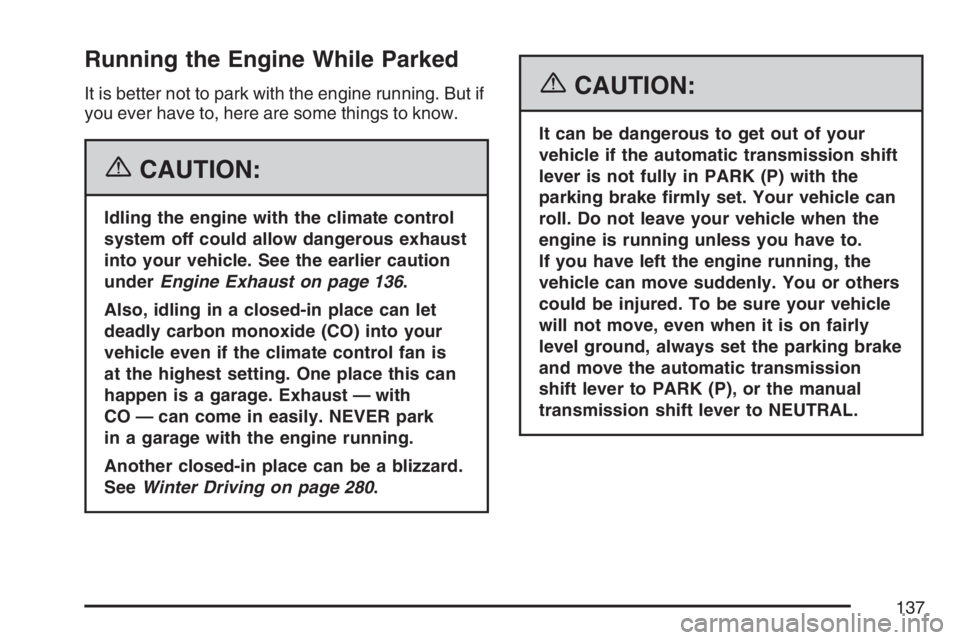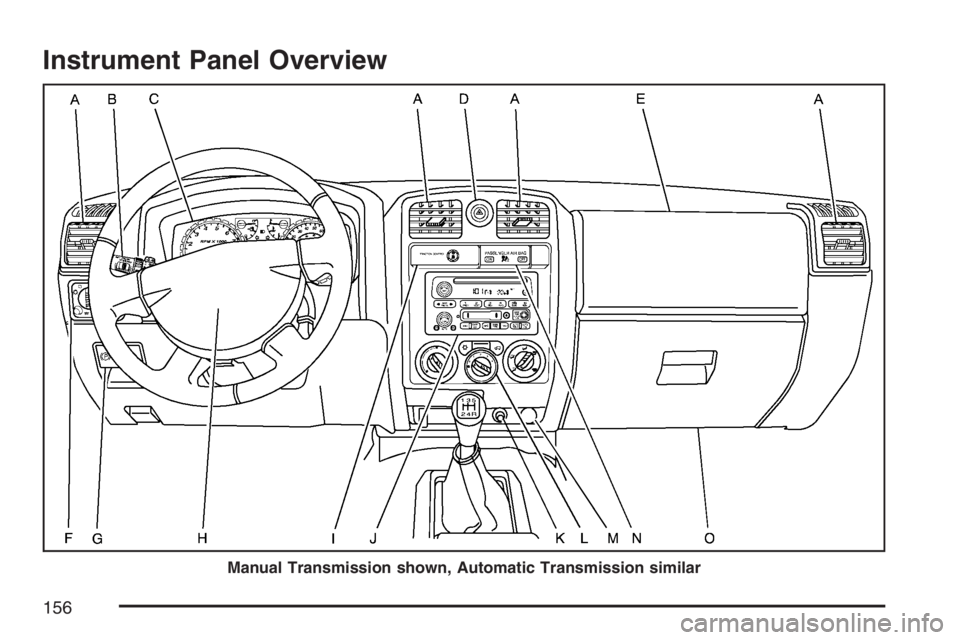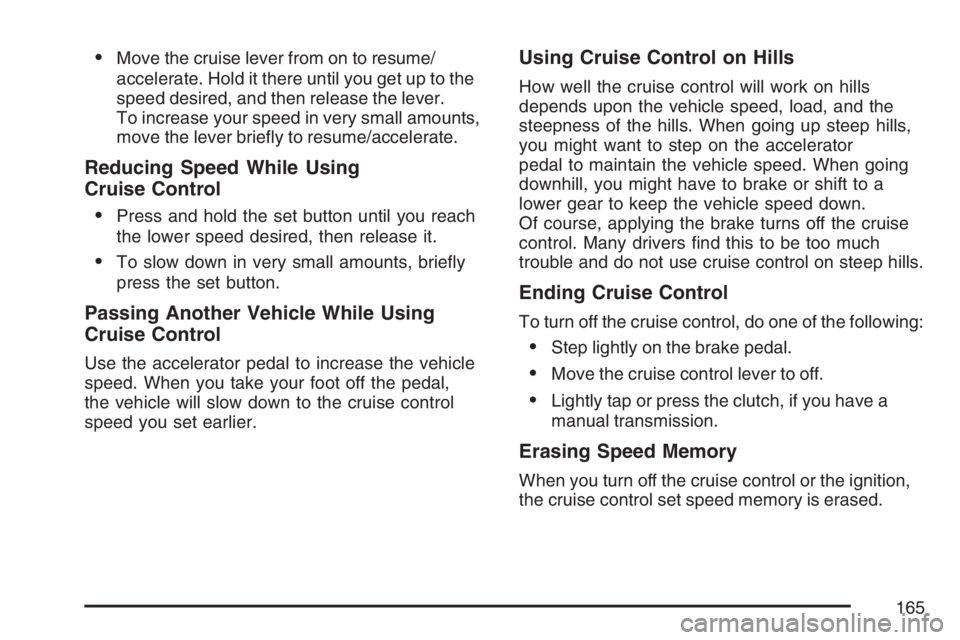2007 GMC CANYON manual transmission
[x] Cancel search: manual transmissionPage 129 of 492

Shifting from Four-Wheel Low to
Two-Wheel High or Four-Wheel High
To shift from Four-Wheel Low to Two-Wheel
High or Four-Wheel High, your vehicle must be
stopped or moving less than 3 mph (5 km/h)
with the transmission in NEUTRAL (N) for
an automatic transmission or the clutch pedal
engaged for a manual transmission. The preferred
method for shifting out of four-wheel low is to
have your vehicle moving 1 to 2 mph
(1.6 to 3.2 km/h).
Press and release the Four-Wheel High or
Two-Wheel High button. You must wait for the
Four-Wheel High or Two-Wheel High indicator
light to stop �ashing and stay on before shifting
the transmission into gear or releasing the
clutch pedal.
If the Four-Wheel High or Two-Wheel High button
is pressed when your vehicle is in gear and/or
moving faster than 3 mph (5km/h), the Four-Wheel
High or Two Wheel High indicator light will �ash
for 30 seconds but not complete the shift.
Shifting to NEUTRAL
Use NEUTRAL when you plan to tow your vehicle.
SeeRecreational Vehicle Towing on page 293
for towing instructions. To shift the transfer case
into NEUTRAL do the following:
1. Set the parking brake.
2. Start the vehicle.
3. Press the regular brake pedal and shift the
transmission in NEUTRAL (N), or press in
the clutch for vehicles with a manual
transmission.
4. Shift the transfer case to Two-Wheel High.
5. Press and hold the Two-Wheel High and
Four-Wheel Low buttons at the same time
for 10 seconds. The NEUTRAL (N) light
will come on when the transfer case shift to
NEUTRAL (N) is complete.
6. Press and hold the regular brake pedal and
shift the transmission to REVERSE (R) for
one second, then shift the transmission
to DRIVE (D) for one second, or FIRST (1) for
vehicles with manual transmissions, and let
out the clutch to insure the transfer case is in
NEUTRAL. If the vehicle is not in NEUTRAL,
repeat this procedure starting at Step 3.
129
Page 130 of 492

7. Turn the engine off by turning the key
to ACC (Accessory).
8. Place the transmission shift lever in
PARK (P), or FIRST (1) for vehicles that
have a manual transmission.
9. Turn the ignition to LOCK.
Shifting Out of NEUTRAL
After towing your vehicle, you will have to shift out
of NEUTRAL in order to drive. To shift out of
NEUTRAL, do the following:
1. Set the parking brake and apply the regular
brake pedal.
2. Start a vehicle with an automatic transmission
in PARK (P). Use FIRST (1) for vehicles with
a manual transmission.
3. Shift the transmission to NEUTRAL (N), or
press the clutch pedal for vehicles with a
manual transmission.
4. Press the button for the desired transfer case
shift position (Two-Wheel High, Four-Wheel
High, or Four-Wheel Low).
5. After the transfer case has shifted out of
NEUTRAL, the indicator light will go out.
6. Release the parking brake.
7. Shift the transmission to the desired position.
Parking Brake
The parking brake pedal
is located to the left of
the regular brake pedal,
near the driver’s door.
To set the parking brake, hold the regular brake
pedal down with your right foot. Push the
parking brake pedal down to its fully-applied
position with your left foot.
A chime will activate and the brake warning light,
located on the instrument panel, will �ash when the
parking brake is applied and the vehicle is moving
at least 3 mph (5 km/h) for at least three seconds.
The chime will deactivate and the light will turn off
when the parking brake is set and the vehicle is
moving below 3 mph (5 km/h). SeeBrake System
Warning Light on page 185.
130
Page 134 of 492

Shifting Out of Park (P)
(Automatic Transmission)
Your vehicle has an automatic transmission shift
lock control system which locks the shift lever
in PARK (P) when the ignition is in the LOCK
position. In addition, you have to fully apply the
regular brakes before you can shift from PARK (P)
when the ignition is in ON. SeeAutomatic
Transmission Operation on page 120.
If you cannot shift out of PARK (P), ease pressure
on the shift lever by pushing the shift lever all
the way into PARK (P) as you maintain brake
application. Then, move the shift lever into
the gear you want.
If you ever hold the brake pedal down but still
cannot shift out of PARK (P), try this:
1. Turn the key to ACC. There is no shift
interlock in this key position.
2. Apply and hold the brake until the end
of Step 4.
3. Shift the transmission to NEUTRAL (N).
4. Start the vehicle and then shift to the
gear you want.
5. Have the system �xed as soon as you can.
Parking Your Vehicle
(Manual Transmission)
Your vehicle has a manual transmission. Before
you get out of your vehicle, move the shift
lever into REVERSE (R), and �rmly apply the
parking brake. Once the shift lever has been
placed into REVERSE (R) with the clutch pedal
pressed in, turn the ignition key to LOCK, remove
the key and release the clutch.
If you are parking on a hill, or if your vehicle is
pulling a trailer, seeTowing a Trailer on page 300.
134
Page 137 of 492

Running the Engine While Parked
It is better not to park with the engine running. But if
you ever have to, here are some things to know.
{CAUTION:
Idling the engine with the climate control
system off could allow dangerous exhaust
into your vehicle. See the earlier caution
underEngine Exhaust on page 136.
Also, idling in a closed-in place can let
deadly carbon monoxide (CO) into your
vehicle even if the climate control fan is
at the highest setting. One place this can
happen is a garage. Exhaust — with
CO — can come in easily. NEVER park
in a garage with the engine running.
Another closed-in place can be a blizzard.
SeeWinter Driving on page 280.
{CAUTION:
It can be dangerous to get out of your
vehicle if the automatic transmission shift
lever is not fully in PARK (P) with the
parking brake �rmly set. Your vehicle can
roll. Do not leave your vehicle when the
engine is running unless you have to.
If you have left the engine running, the
vehicle can move suddenly. You or others
could be injured. To be sure your vehicle
will not move, even when it is on fairly
level ground, always set the parking brake
and move the automatic transmission
shift lever to PARK (P), or the manual
transmission shift lever to NEUTRAL.
137
Page 138 of 492

{CAUTION:
Four-wheel drive vehicles with the transfer
case in NEUTRAL will allow the vehicle to
roll, even if your automatic transmission
shift lever is in PARK (P). So, be sure the
transfer case is in a drive gear — not in
NEUTRAL. Always set your parking brake.
Follow the proper steps to be sure your vehicle
will not move. SeeShifting Into Park (P)
(Automatic Transmission) on page 132.
If you are pulling a trailer, seeTowing a Trailer
on page 300.
Mirrors
Manual Rearview Mirror
While sitting in a comfortable driving position,
adjust the mirror so you can see clearly behind
your vehicle. Grip the mirror in the center to move
it up or down and side to side. The control at
the bottom of the mirror is the day/night feature
that allows adjustment to the mirror so that
the glare of headlamps from behind is reduced.
Push the control for daytime use; pull it for
night use.
Manual Rearview Mirror with
OnStar
®
Mirror Operation
Your vehicle may have a manual rearview mirror
with the OnStar®System. You can adjust the mirror
for day or night driving. Press the tab forward for
day driving. Pull the tab back for night driving.
138
Page 153 of 492

Instrument Panel Overview........................ 156
Hazard Warning Flashers.......................... 158
Other Warning Devices............................. 158
Horn.......................................................... 158
Tilt Wheel.................................................. 158
Turn Signal/Multifunction Lever.................. 159
Turn and Lane-Change Signals................. 160
Headlamp High/Low-Beam Changer.......... 161
Flash-to-Pass............................................ 161
Windshield Wipers..................................... 161
Windshield Washer.................................... 162
Cruise Control........................................... 163
Exterior Lamps.......................................... 166
Headlamps on Reminder........................... 167
Daytime Running Lamps (DRL)................. 167
Automatic Headlamp System..................... 168
Fog Lamps................................................ 169
Exterior Cargo Lamps................................ 169
Interior Lamps........................................... 170
Instrument Panel Brightness...................... 170
Dome Lamp.............................................. 170
Dome Lamp Override................................ 170
Exit Lighting.............................................. 171
Electric Power Management...................... 171
Battery Run-Down Protection..................... 171Accessory Power Outlet(s)........................ 172
Ashtray(s) and Cigarette Lighter................ 173
Climate Controls......................................... 173
Climate Control System............................. 173
Outlet Adjustment...................................... 176
Warning Lights, Gages, and Indicators..... 177
Instrument Panel Cluster........................... 178
Speedometer and Odometer...................... 179
Trip Odometer........................................... 179
Tachometer............................................... 179
Safety Belt Reminder Light........................ 180
Passenger Safety Belt Reminder Light....... 180
Airbag Readiness Light............................. 181
Passenger Airbag Status Indicator............. 182
Battery Warning Light................................ 184
Up-Shift Light (Manual Transmission)........ 185
Brake System Warning Light..................... 185
Anti-Lock Brake System Warning Light...... 186
Engine Coolant Temperature Gage............ 187
Tire Pressure Light.................................... 187
Malfunction Indicator Lamp........................ 188
Oil Pressure Light..................................... 191
Security Light............................................ 192
Cruise Control Light.................................. 192
Section 3 Instrument Panel
153
Page 156 of 492

Instrument Panel Overview
Manual Transmission shown, Automatic Transmission similar
156
Page 165 of 492

Move the cruise lever from on to resume/
accelerate. Hold it there until you get up to the
speed desired, and then release the lever.
To increase your speed in very small amounts,
move the lever brie�y to resume/accelerate.
Reducing Speed While Using
Cruise Control
Press and hold the set button until you reach
the lower speed desired, then release it.
To slow down in very small amounts, brie�y
press the set button.
Passing Another Vehicle While Using
Cruise Control
Use the accelerator pedal to increase the vehicle
speed. When you take your foot off the pedal,
the vehicle will slow down to the cruise control
speed you set earlier.
Using Cruise Control on Hills
How well the cruise control will work on hills
depends upon the vehicle speed, load, and the
steepness of the hills. When going up steep hills,
you might want to step on the accelerator
pedal to maintain the vehicle speed. When going
downhill, you might have to brake or shift to a
lower gear to keep the vehicle speed down.
Of course, applying the brake turns off the cruise
control. Many drivers �nd this to be too much
trouble and do not use cruise control on steep hills.
Ending Cruise Control
To turn off the cruise control, do one of the following:
Step lightly on the brake pedal.
Move the cruise control lever to off.
Lightly tap or press the clutch, if you have a
manual transmission.
Erasing Speed Memory
When you turn off the cruise control or the ignition,
the cruise control set speed memory is erased.
165